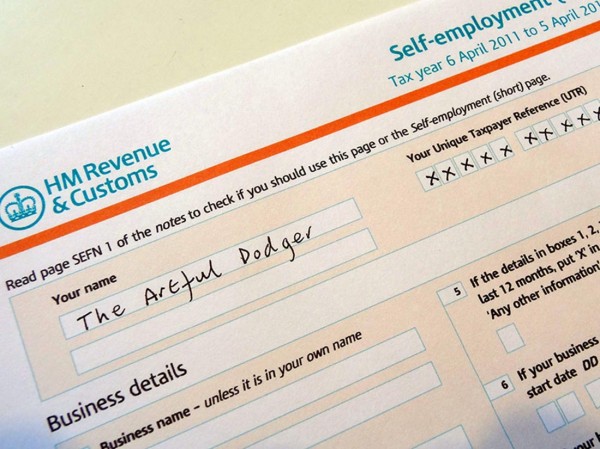 The UK Chancellor of the Exchequer, Philip Hammond, announced in the Budget this week that national insurance contributions (NICs) for self-employed people will rise from 9% to 11% by 2019. These are known as ‘Class 4’ NICs. The average self-employed person will pay around £240 more per year, but those on incomes over £45,000 will pay £777 more per year. Many of the people affected will be those working in the so-called ‘gig economy’. This sector has been growing rapidly in recent years and now has over 4 million people working in it.
The UK Chancellor of the Exchequer, Philip Hammond, announced in the Budget this week that national insurance contributions (NICs) for self-employed people will rise from 9% to 11% by 2019. These are known as ‘Class 4’ NICs. The average self-employed person will pay around £240 more per year, but those on incomes over £45,000 will pay £777 more per year. Many of the people affected will be those working in the so-called ‘gig economy’. This sector has been growing rapidly in recent years and now has over 4 million people working in it.
Workers in the gig economy are self employed, but are often contracted to an employer. They are paid by the job (or ‘gig’: like musicians), rather than being paid a wage. Much of the work is temporary, although many in the gig economy, such as taxi drivers and delivery people stick with the same job. The gig economy is just one manifestation of the growing flexibility of labour markets, which have also seen a rise in temporary employment, part-time employment and zero-hour contracts.
 Working in the gig economy provides a number of benefits for workers. Workers have greater flexibility in their choice of hours and many work wholly or partly from home. Many do several ‘gigs’ simultaneously, which gives variety and interest.
Working in the gig economy provides a number of benefits for workers. Workers have greater flexibility in their choice of hours and many work wholly or partly from home. Many do several ‘gigs’ simultaneously, which gives variety and interest.
In terms of economic theory, this flexibility gives workers a greater opportunity to work the optimal amount of time. This optimum involves working up to the point where the marginal benefit from work, in terms of pay and enjoyment, equals the marginal cost, in terms of effort and sacrificed leisure.
For firms using people from the gig economy, it has a number of advantages. They are generally cheaper to employ, as they do not need to be paid sick pay, holiday pay or redundancy; they are not entitled to parental leave; there are no employers’ national insurance contributions to pay (which are at a rate of 13.8% for employers); the minimum wage does not apply to such workers as they are not paid a ‘wage’. Also the firm using such workers has greater flexibility in determining how much work individuals should do: it chooses the amount of service it buys in a similar way that consumers decide how much to buy.
 Many of these advantages to firms are disadvantages to the workers in the gig economy. Many have little bargaining power, whereas many firms using their services do. It is not surprising then that the Chancellor’s announcement of a 2 percentage point rise in NICs for such people has met with such dismay by the people affected. They will still pay less than employed people, but they claim that this is now not enough to compensate for the lack of benefits they receive from the state or from the firms paying for their services.
Many of these advantages to firms are disadvantages to the workers in the gig economy. Many have little bargaining power, whereas many firms using their services do. It is not surprising then that the Chancellor’s announcement of a 2 percentage point rise in NICs for such people has met with such dismay by the people affected. They will still pay less than employed people, but they claim that this is now not enough to compensate for the lack of benefits they receive from the state or from the firms paying for their services.
Some of the workers in the gig economy can be seen as budding entrepreneurs. If you have a specialist skill, you may use working in the gig economy as the route to setting up your own business and employing other people. A self-employed plumber may set up a plumbing company; a management consultant may set up a management consultancy agency. Another criticism of the rise in Class 4 NICs is that this will discourage such budding entrepreneurs and have longer-term adverse supply-side effects on the economy.
 As far as the government is concerned, there is a worry about people moving from employment to self-employment as it tends to reduce tax revenues. Not only will considerably less NIC be paid by previous employers, but the scope for tax evasion is greater in self-employment. There is thus a trade-off between the extra output and small-scale investment that self-employment might bring and the lower NIC/tax revenue for the government.
As far as the government is concerned, there is a worry about people moving from employment to self-employment as it tends to reduce tax revenues. Not only will considerably less NIC be paid by previous employers, but the scope for tax evasion is greater in self-employment. There is thus a trade-off between the extra output and small-scale investment that self-employment might bring and the lower NIC/tax revenue for the government.
Articles
Thriving in the gig economy Philippine Daily Inquirer, Michael Baylosis (10/3/17)
6 charts that show how the ‘gig economy’ has changed Britain – and why it’s not a good thing Business Insider, Ben Moshinsky (21/2/17)
What is the ‘gig’ economy? BBC News, Bill Wilson (10/2/17)
Great Freelance, Contract and Part-Time Jobs for 2017 CareerCast (10/3/17)
We have the laws for a fairer gig economy, we just need to enforce them The Guardian, Stefan Stern (7/2/17)
The gig economy will finally have to give workers the rights they deserve Independent, Ben Chu (12/2/17)
Gig economy chiefs defend business model BBC News (22/2/17)
Spring Budget 2017 tax rise: What’s the fuss about? BBC News, Kevin Peachey (9/3/17)
Self-employed hit by national insurance hike in budget The Guardian, Simon Goodley and Heather Stewart (8/3/17)
What national insurance is – and where it goes The Conversation, Jonquil Lowe (10/3/17)
Britain’s tax raid on gig economy misses the mark Reuters, Carol Ryan (9/3/17)
Economics collides with politics in Philip Hammond’s budget The Economist (9/3/17)
UK government publications
Contract types and employer responsibilities – 5. Freelancers, consultants and contractors GOV.UK
Spring Budget 2017 GOV.UK (8/3/17)
Spring Budget 2017: documents HM Treasury (8/3/17)
National Insurance contributions (NICs) HMRC and HM Treasury (8/3/17)
Questions
- Give some examples of work which is generally or frequently done in the gig economy.
- What are the advantages and disadvantages to individuals from working in the gig economy?
- What are the advantages and disadvantages to firms from using the services of people in the gig economy rather than employing people?
- In the case of employed people, both the employees and the employers have to pay NICs. Would it be fair for both such elements to be paid by self-employed people on their own income?
- Discuss ways in which the government might tax the firms which buy the services of people in the gig economy.
- How does the rise of the gig economy affect the interpretation of unemployment statistics?
- What factors could cause a substantial growth in the gig economy over the coming years?
In the midst of the election campaign we can well imagine that economic data are analysed in minute detail by politicians looking to make political capital. Of particular interest are likely to be the labour market numbers. So here we ‘digest’ a few of the latest numbers from the latest ONS labour market release.
The ONS reports that in the three months to February 2010 the number unemployed in the UK rose above the 2½ million mark to stand at 2.502 million. Of these, 61.2% were male and 38.8% female. The rise of 43,000 on the previous three months (i.e. the three months to November) took unemployment to its highest level since the three months to December 1994.
While unemployment rose, employment fell by 90,000 over the same period to 28.824 million. Of those in employment, 53.2% were male and 46.8% female. Employment levels are now at their lowest since the three months to December 2005. The latest unemployment and employment numbers mean that the number of economically active individuals in the three months to February stood at 31.326 million (53.9% male and 46.1% female), down by 47,000 on the previous three months. Therefore the unemployment rate, which is expressed as a percentage of those economically active, has now edged up to 8% (9.1% amongst males and 6.7% amongst females); it was 6.8% a year ago (7.6% amongst males and 5.9% amongst females) and 5.2% two years ago (5.6% amongst males and 4.8% amongst females).
If we look at the number who have been unemployed for at least one year we see a rather worrying trend with a rise of 89,000 over the past three months to some 726,000. This compares with 486,000 in the same period a year ago and 390,000 two years ago. Another potentially problematic trend is the rise in inactivity rates. The proportion of individuals of working age who are now inactive, so neither employed or actively seeking work, rose to 21.5% in the three months to February (17.5% amongst men and 25.8% amongst females), up from 20.7% in the same period last year (16.2% amongst men and 25.7% amongst females).
Finally, part-time employment fell by 30,000 in the three months to February to 7.671 million. However, it rose by 6000 amongst men to 1.880 million. We now observe that 12.2% of men in employment are employed part-time compared with 43.0% of females in employment. Further, of all part-time workers 24.5% – that’s effectively one-quarter – are male, double the share back in 1984 when these numbers were first recorded.
Articles
UK Unemployment hits 2.5 million mark The Wall Street Journal, Nicholas Winning and Ilona Billington (21/4/10)
UK unemployment at 16-year high Financial Times, Brian Groom (21/4/10)
UK unemployment increases to 2.5 million BBC News (21/4/10) )
Unemployment breaks through 2.5 million Guardian, Graeme Wearden (21/4/10)
UK unemployment surges to 15-year high The Times, Grainne Gilmore (21/4/10)
Data
Latest on employment and unemployment Office for National Statistics (21/4/10)
Labour Market Statistics, April 2010 Office for National Statistics (21/4/10)
Labour market statistics page Office for National Statistics
For macroeconomic data for EU countries and other OECD countries, such as the USA, Canada, Japan, Australia and Korea, see:
AMECO online European Commission
Questions
- The current rate of unemployment is 8%. During the downturn of the early 1990s it peaked at 10.7%. What might explain this difference? Do you think the current rate may have now peaked?
- What might explain the rise in inactivity rates? Does this rise have any implications for potential output?
- Does the rise in the number of those unemployed for over a year have implications for our potential output?
- Go back through the commentary: are there any notable gender differences in the figures? What factors might help to explain these?
- In 1984 part-time employment stood at 4.985 million while currently the figure is 7.671 million. Is it possible to explain this growth in part-time employment in the UK?
It is often said of statistics that you can make of them whatever you want to. Well, this appears especially true of the latest labour market figures from the Office for National Statistics. Firstly, the good news: unemployment fell. But, secondly, the not so good news: the number of economically inactive individuals rose to an all-time high. So what are we supposed to make of the latest figures? And, are there any other little gems to be uncovered in the latest set of labour market numbers?
At its most simple, an economically active individual is somebody 16 or over who is either in employment or is unemployed but actively seeking work. In the three months to January 2010, the total number of economically active individuals in the UK stood at 31.309 million, of which 28.860 million were employed and 2.449 million were unemployed. The number unemployed in the previous three months had been at 2.482 million. When expressed as a percentage of those economically active, the unemployment rate has fallen from 7.9% in the previous three months to 7.8% in the three months to January.
The total number of economically inactive individuals of working age, i.e. those aged 16 to 59 (women) or 64 (men), stood at 8.157 million in the three months to January, which, as well being an historic high, was a rise from 8.009 million in the previous three months. This converts into an inactivity rate amongst those of working age of some 21.5%, the highest since the three months to October 2004. A key point though is that inactivity rates do tend to rise either during periods of rising unemployment and/or following prolonged periods of relatively high unemployment. For instance, following the early 1990s downturn the rate of inactivity peaked at 22.1% in the three months to January 1995. In comparison, following the boom of the late 1980s the rate, the inactivity rate began the 1990s at only 19.3% – a record low. A large contributing factor to the rise in inactivity in the three months to January has been the rise in the number of students not in the labour market to 2.13 million, an increase of some 98,000 over the three months. Again, parallels can be drawn with the early 1990s because this is the highest number of students not in the labour market since comparable figures began in 1993.
In part, it appears that inactivity levels reflect perceptions amongst individuals of the probability of finding employment. So, while unemployment has fallen by 33,000 over the latest three months we do have to keep in mind that inactivity has increased by 149,000. Therefore, this may be a case of a ‘jobless’ decrease in unemployment!
Some commentators, however, are more optimistic about the current trend in unemployment, pointing to the fact that unemployment levels have not hit the levels predicted, despite the economy contracting by 5% in 2009. They point to the flexible labour market. Of course, time will tell if this is truly a ‘benefit’ of a more flexible labour market. But, what is clear is that one manifestation of a changing structure to the UK labour market is the growth in part-time work. In the three months to January, 26.69% of those employed were employed part-time: this was another record high which seems to have been largely lost in the mass of statistics.
Articles
Unemployment falls as ‘economic inactive hits record’ Telegraph, Harry Wallop (17/3/10)
Unemployment plunge boost economy hopes thisismoney, Ed Monk (17/3/10)
UK unemployment records further fall BBC News (17/3/10) )
Gordon Brown given unexpected boost by fall in unemployment Guardian, Kathryn Hopkins and Julia Kollewe (17/3/10)
Not lagging, but not leading either BBC News blogs: Stephanomics, Stephanie Flanders (17/3/10)
Data
Latest on employment and unemployment Office for National Statistics (17/3/10)
Labour market statistics, March 2010 Office for National Statistics (17/3/10)
Labour Market Statistics page Office for National Statistics
For macroeconomic data for EU countries and other OECD countries, such as the USA, Canada, Japan, Australia and Korea, see:
AMECO online European Commission
Questions
- What factors do you think could affect labour market inactivity rates?
- How might inactivity rates affect an economy’s potential output?
- What factors do you think will have contributed to the growth in part-time employment in the UK?
- The UK economy came out of recession in the last quarter of 2009. Does this mean that unemployment will continue to fall from now on?
 The UK Chancellor of the Exchequer, Philip Hammond, announced in the Budget this week that national insurance contributions (NICs) for self-employed people will rise from 9% to 11% by 2019. These are known as ‘Class 4’ NICs. The average self-employed person will pay around £240 more per year, but those on incomes over £45,000 will pay £777 more per year. Many of the people affected will be those working in the so-called ‘gig economy’. This sector has been growing rapidly in recent years and now has over 4 million people working in it.
The UK Chancellor of the Exchequer, Philip Hammond, announced in the Budget this week that national insurance contributions (NICs) for self-employed people will rise from 9% to 11% by 2019. These are known as ‘Class 4’ NICs. The average self-employed person will pay around £240 more per year, but those on incomes over £45,000 will pay £777 more per year. Many of the people affected will be those working in the so-called ‘gig economy’. This sector has been growing rapidly in recent years and now has over 4 million people working in it. Working in the gig economy provides a number of benefits for workers. Workers have greater flexibility in their choice of hours and many work wholly or partly from home. Many do several ‘gigs’ simultaneously, which gives variety and interest.
Working in the gig economy provides a number of benefits for workers. Workers have greater flexibility in their choice of hours and many work wholly or partly from home. Many do several ‘gigs’ simultaneously, which gives variety and interest. Many of these advantages to firms are disadvantages to the workers in the gig economy. Many have little bargaining power, whereas many firms using their services do. It is not surprising then that the Chancellor’s announcement of a 2 percentage point rise in NICs for such people has met with such dismay by the people affected. They will still pay less than employed people, but they claim that this is now not enough to compensate for the lack of benefits they receive from the state or from the firms paying for their services.
Many of these advantages to firms are disadvantages to the workers in the gig economy. Many have little bargaining power, whereas many firms using their services do. It is not surprising then that the Chancellor’s announcement of a 2 percentage point rise in NICs for such people has met with such dismay by the people affected. They will still pay less than employed people, but they claim that this is now not enough to compensate for the lack of benefits they receive from the state or from the firms paying for their services. As far as the government is concerned, there is a worry about people moving from employment to self-employment as it tends to reduce tax revenues. Not only will considerably less NIC be paid by previous employers, but the scope for tax evasion is greater in self-employment. There is thus a trade-off between the extra output and small-scale investment that self-employment might bring and the lower NIC/tax revenue for the government.
As far as the government is concerned, there is a worry about people moving from employment to self-employment as it tends to reduce tax revenues. Not only will considerably less NIC be paid by previous employers, but the scope for tax evasion is greater in self-employment. There is thus a trade-off between the extra output and small-scale investment that self-employment might bring and the lower NIC/tax revenue for the government.